Nigeria
Recipes
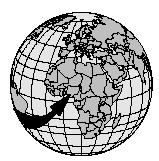
1 GEOGRAPHIC SETTING AND ENVIRONMENT
The name Nigeria is taken from the Niger River, which plays an important part in Nigerian lives. Not only is it a transportation highway, it is an excellent source of fish, including carp, Nile perch, and catfish. It also provides the water needed to cultivate crops.
Nigeria is located on the west coast of Africa at the inner corner of the Gulf of Guinea (part of the Atlantic Ocean). Its land area is comparable to being about twice the size of California.
An area of mangrove (a type of tropical tree) swamp forest lines the coast of Nigeria. Beyond the forest lies a wide tropical forest, then a plateau that leads to the Shebshi Mountains (on the eastern side of the country). The extreme north borders on the Sahara Desert.
Many different climates mirror the varied land regions, although Nigeria is mostly in a tropical zone. On the coast, it is very humid, and the nights are hot. Inland there is a wet season from April to October and a dry season from November to March.
2 HISTORY AND FOOD
Trade was largely responsible for changing the flavors of African cuisine. Before trading between continents began, main staples included rice, millet (a type of grain), and lentils. The Portuguese were the first Europeans to reach Nigeria. There, they established a slave trade center around the 1400s. Portuguese explorers and traders introduced cassava to western Africa (including present-day Nigeria) through their trade with the African coasts and nearby islands. British, Dutch, and other European traders later competed for control of the trade. By the 1700s, the British were the main traders of slaves on the Nigerian coast.
European explorers and traders introduced several food staples to western Africa, such as beans, cassava, and maize. These foods were introduced to the explorers
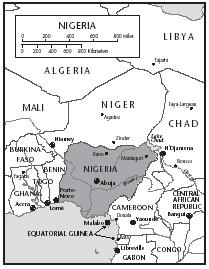
3 FOODS OF THE NIGERIANS
Nigeria is one of the world's most ethnically diverse countries. The Hausa and Yoruba make up around 21 percent of the population; the Igbo/Ibo, 18 percent; the Fulani, around 11 percent; and Ibibio, 5 percent. Various other groups make up the remaining 23 percent.
Nigeria has such a variety of people and cultures that it is difficult to pick one national dish. Each area has its own regional favorite that depends on customs, tradition, and religion. The different foods available also depend on the season: the "hungry season" is before the rains arrive in March, and the "season of surplus" follows the harvest in October and November. Fruits, however, are enjoyed year-round. A large part of Nigeria lies in the tropics, where many fruits are available. Some of the popular fruits are oranges, melons, grapefruits, limes, mangoes, bananas, and pineapples.
People of the northern region (mostly Muslim, whose beliefs prohibit eating pork) have diets based on beans, sorghum (a type of grain), and brown rice. The Hausa people of this region also like to eat meat in the form of tsere or suya (kebabs, which are chunks of roasted, skewered meat). Muslims love to drink tea, making coffeehouses popular places to socialize.
The people from the eastern part of Nigeria, mostly Igbo/Ibo, eat gari (cassava powder) dumplings, pumpkins, and yams. Yams are usually eaten in place of potatoes and are an important part of the Nigerian diet. However, African yams are different than Western yams. They are pale, barely sweet, and are not commonly found in United States supermarkets.
Isu (Spiced Boiled Yams)
Ingredients
- 2 pounds yams, peeled and thickly sliced (regular yams can be used in place of African yams)
- ½ teaspoon salt
- 1 clove garlic
- 1 teaspoon cinnamon
- 4 Tablespoons butter, melted
- Cayenne pepper, to taste
Procedure
- Place the yams in a large saucepan and add enough water to cover them.
- Add the salt, garlic clove, and cinnamon. Bring to a boil.
- Reduce heat to medium and cook until tender, 15 to 20 minutes.
- Drain the yams and remove the garlic clove and discard it.
- Place the yams on a platter and drizzle the butter over the top.
- Sprinkle with a little cayenne pepper (be careful, cayenne pepper tastes very hot) and serve.
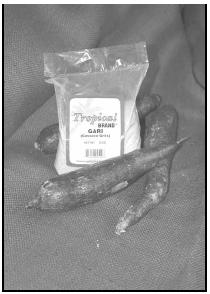
The Yoruba people of the southwest and central areas eat gari with local varieties of okro (okra) and spinach in stews or soups. They also like to eat mashed yams or mashed cassava.
Near the coast of the Gulf of Guinea, Nigerians prefer eating seafood stews (made with fish, shrimp, crab, and lobster), yams, rice, and vegetables. Fish is important to the Nigerian diet since it is one of only a few sources of protein. A common way coastal Nigerians prepare fish is to make a marinade of ginger, tomatoes, and cayenne pepper, and then cook the fish in peanut oil. Efo (stews) are also popular.
Nigerian Stew
Ingredients
- 2 pounds fish fillets, thinly sliced (although it won't be authentic Nigerian, chicken may be substituted for fish)
- Salt, to taste
- Pinch of thyme
- ¼ cup red bell pepper, minced
- ¾ cup tomato paste (6-ounce can)
- 1 medium onion, chopped
- 4 cups water
- ¼ cup peanut or vegetable oil
- 1 chicken bouillon cube
Procedure
- Season fish fillets with salt and thyme. Set aside.
- Place the pepper, tomato paste, onion, and water in a large pot.
- Cook for 10 minutes over medium heat.
- Add the oil and bouillon cube. Simmer over low heat for 15 minutes.
- Add the seasoned fish fillets and simmer for 10 minutes. (If using chicken, simmer for 20 minutes.) Serve with rice.
Serves at least 8.
People living in the cities tend to buy their food from "chop bars" (bars that sell food), street vendors, hawkers (peddlers who shout what they are selling), or from restaurants. They may purchase dishes such as ukwaka , a steamed pudding made from corn and ripe plantains, and moin-moin , a steamed cake of ground dried beans and fish. These dishes may be served with jollof rice (a spicy tomato-based rice), cassava, yams, okro , beans, plantains, or kebabs.
Nigerian stews, such as ikokore (made with fish and yams), are typically spicy and eaten with rice, yams, cassava, and corn. Peppers and chilies are used regularly in dishes and as a relish. A Yoruba Proverb says, "The man that eats no pepper is weak, pepper is the staff of life..."
4 FOOD FOR RELIGIOUS AND HOLIDAY CELEBRATIONS
Nigerians practice traditional African religious beliefs in addition to various branches of Islam and Christianity. Muslims make up 45 percent of the population. Muslim and
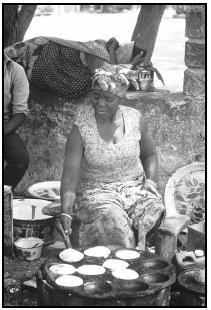
Jollof Rice
Ingredients
- 1 large onion, chopped
- 2 Tablespoons vegetable oil
- 2 teaspoons tomato paste
- 1½ cups cooked rice
- 1 green chili, seeded and chopped (green pepper can be substituted)
- 1 cup meat or vegetable stock
Procedure
- Cook the rice according to package directions.
- Heat the oil in a frying pan and sauté the onion until soft, but not browned.
- Add the tomato paste and chili and cook on medium heat while stirring, about 2 minutes.
- Add the rice and continue stirring.
- Add the stock and bring the mixture to a boil.
- Reduce heat to medium and cook until almost all of the stock has evaporated. Serve.
Makes 4 servings.
Iyan (Pounded Yams)
African yams are not readily available elsewhere in the world, so regular yams may be substituted.
Ingredients
- 4 yams, peeled (canned yams may be substituted, if necessary)
- Water
- Salt, to taste
Procedure
- Rinse the yams in water and slice them into chunks. Place chunks in a large pot or saucepan. If substituting canned yams, pour the contents of the can into a saucepan, but do not add additional water.
- Bring to a boil and cook, uncovered, about 20 minutes (10 minutes for canned yams), or until soft enough that a fork is easily inserted.
- Drain the yams and place them into a blender (or mash by hand). Blend until smooth.
- Season with salt and serve with soup or stew.
Serves 6.
Besides religious holidays, there are many cultural festivals throughout the year. The Argungu Fish and Cultural Festival is held on the banks of the River Sokoto. Several months before the festival, the River Sokoto is dammed (blocked at a certain point). When the celebration begins, hundreds of fishermen jump into the river at once to scare the fish into the air and into waiting nets.
Igbo Day is a festival of Iri-ji , which means, "new-yam eating." It is held by the Igbo people in Nigeria in August and is a day to celebrate the end of the cultivation season. The oldest man in the community performs the solemn ritual of eating the first new yam. This ritual is meant to express the community's appreciation to the gods for making the harvest of farm crops possible. Only yams are served at the festival.
5 MEALTIME CUSTOMS
Many Nigerians rise as early as 5 A.M. , when a small breakfast is eaten to begin their day. Breakfast usually consists of rice and mangoes, or stewed soybeans. Dodo (fried plantains) is a common dish, as well as leftovers from the night before.
Lunch is eaten around 11 A.M. and considered the most important meal of the day. A late dinner may be served with dishes similar to those offered at lunch. Most Nigerian meals are made up of one course and are cooked outside over an open fire (gas and kerosene stoves are sometimes used, but the two fuels are very expensive for many Nigerians). Dishes such as efo (stew) or moin-moin may be served at lunch. Soups and stews are common lunchtime foods, eaten with hands cupped like a spoon. Many Nigerians only use their right hand. In southern Nigeria, two favorite soups are egusi soup and palm nut soup. Egusi is a spicy yellow soup made with meat, red chilies, ground dried shrimp, and greens. Palm nut soup is a stew made with meat, chilies, tomatoes, onions, and palm nut oil.
Efo (Greens Stew)
Ingredients
- 1 pound collard greens or spinach
- 1 can (8-ounce) tomato paste
- 1 can (8-ounce) tomato puree
- 1 large onion, diced
- l Tablespoon vegetable oil
Procedure
- Wash the greens and tear into small pieces.
- In a large pot or saucepan, place the greens in water and add the oil.
- Boil greens until tender.
- Add tomato paste, tomato puree, and diced onion.
- Reduce heat to medium and simmer until vegetables are tender. Serve.
Makes 4 to 6 servings.
Lunch and evening meals are typically served on large communal plates and shared among children according to their gender and age. Young children may eat from a dish with their mother, but when they reach the age of seven or eight, the boys and girls are separated and meals are eaten with members of the same sex.
Dodo (Fried Plantains)
Plantains are slightly larger than bananas and can be found in most supermarkets. When ripe, their skins are yellowish green or yellow (or black if extremely ripe). Plantains do not taste sweet, like yellow bananas.
Ingredients
- 4 ripe plantains, peeled and sliced
- Vegetable oil, for frying
- Salt, to taste
Procedure
- Heat oil in a large frying pan.
- Place the sliced plantains in the frying pan and fry, turning as needed, until golden brown.
- Drain on paper towels.
- Season with salt and serve hot or warm.
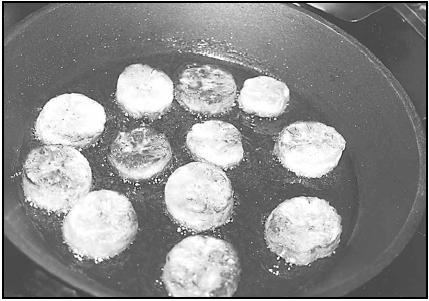
Nigerians enjoy many different snacks that are eaten throughout the day. Some examples are fried yam chips, boiled groundnuts, and meat pastries. Akara, which is a puffy, deep-fried cake made with black-eyes peas, is sometimes eaten with chili dip. Other snacks are kulikui (small deep-fried balls of peanut paste), suya , a hot and spicy kebab, and a few sweets like chinchin (fried pastries in strips). Snack foods are an important part of a child's diet. Fresh fruits (mangoes are a favorite to many), fried bean cakes, cookies, or candy are commonly sold by street vendors. Snacks provide an opportunity for children to eat on their own, without having to share with siblings.
Chinchin
Ingredients
- 3 cups flour
- 1 cup butter or margarine
- 1 egg
- 1 teaspoons baking powder
- ½ cup water
- ½ cup milk (or an additional cup of water)
- Sugar
- Vegetable oil, for frying
Procedure
- Mix all the ingredients together (except oil) to form a dough.
- Sprinkle some flour on a cutting board or other flat surface. Knead the dough until smooth (about 10 minutes).
- Tear off a piece of dough and flatten it (about ½-inch thick) on the cutting board.
- Cut the dough into 1-inch squares.
- Pour some sugar in a paper bag (to coat the chinchin after it is fried).
- Heat the oil in a frying pan over medium heat.
- Place a few of the squares into the oil and fry until golden brown.
- Place the fried chinchin on a paper towel for a few seconds to soak up the extra oil (do not cool).
- Place the chinchin into the bag of sugar and shake to coat all sides. Serve.
Makes about three dozen.
6 POLITICS, ECONOMICS, AND NUTRITION
About 8 percent of the population of Nigeria are classified as undernourished by the World Bank. This means they do not receive adequate nutrition in their diet. Of children under the age of five, about 39 percent are underweight, and over 39 percent are stunted (short for their age).
Many families are fairly self-sufficient where food is concerned. They harvest their own food crops, such as yams, cassava, corn, and millet.
7 FURTHER STUDY
Books
DeWitt, Dave. Flavors of Africa: Spicy African Cooking. Rocklin, CA: Prima Publishing, 1998.
Hafner, Dorinda. A Taste of Africa . Berkeley, CA: Ten Speed Press, 1993.
Imoisi, Janice. Cooking Nigerian Style: Delicious African Recipes . Houston, TX: Gayle Publishing., 2000.
Nason, Ian. Enjoy Nigeria: A Travel Guide. Ibadan: Spectrum Books Ltd., 1991.
West Africa. Melbourne, Oakland, CA: Lonely Planet Publications, 1999.
Web Sites
IWon.com. [Online] Available http://www.iwon.com/home/food_n_drink/globaldest_overview/0,15463,801,00.html (accessed April 12, 2001).
Emeagwali.com. [Online] Available http://emeagwali.com/nigeria/cuisine/nigerian-jollofrice.html (accessed April 12, 2001).
Recipes from Nigeria. [Online] Available http://www.siftthru.com/recipes_from_nigeria.htm (accessed August 17, 2001).
AFANG SOUP (CALABAR, CROSS RIVER STATE)
Ingredient (Serve 8)
1kg meat
1kg dry fish
500g Cow skin (Kpomo, Ikpa)
100g Periwinkle (mfi)
500g Sarki
1 hand of stockfish (Ekporoko)
Sliced Afang (1 small bundle)
Waterleaf (10 heaps)
Salt to taste
2 knorr cubes
Dry pepper
16-ounce crayfish
Palm oil (350ml)
Procedure
Season meat, periwinkle, cow skin, sarki with salt, pepper and knorr cubes and allow to cook till ingredients are soft, then add dry fish and stockfish and allow to cook for about 10minutes till no water in the pot.
Add washed and sliced waterleaf into the cooking pot and allow to cook for about 10mins stirring at intervals. Add crayfish, pepper and salt to taste, then add palm oil, stir the mixture and allow to cook for about 10mnutes then add pounded afang leaf and allow to cook for 5 minutes over medium heat. Serve with fofo, eba, semovita or pounded yam.
Thanks,
Patrick
Thanks for putting up these recipes.. As a Nigerian college student in the US, I really miss home cooked Nigerian food a LOT.
INGREDIENTS
- 1 bowl of dried zobo leaves
- 1 teaspoon Ginger
- Flavours: You may or may not add your flavour before boiling
- Sweeteners or sugar or honey
- Garlic
- Lime or lemon juice (optional)
- Pineapple peels or juice (for pine apple flavour, wash the back properly before chopping the whole fruit both the back and the inside.)
Preparation:
You may wash the dried Zobo leaves properly in ordinary water to get rid of sand and particles, put the Zobo in a cooking pot. Add moderate amount of water cold or boiling and allow to boil for about 10 to 15 minutes.
Add the grind or grated ginger and garlic, the pineapple peels and the lemon rinds and allow to boil for over 15mins
Remove from heat, allow it to cool down and sieve with a fine sift into a big bowl to remove residue. Add sugar or honey to taste when still hot and stir properly.
Add flavours e.g strawberry, pineapple, apple, orange and any other flavour used in baking. There are no side effects for the naturally prepared zobo. Avoid too much sugar and all the sweetening flavours. The more natural, the healthier!
Put in bottles and chill immediately to prevent fermentation. Serve chilled. If too thick dilute with water before serving. However, if you live in a cold country, you can take the drink hot in place of your usual coffee!
MMary